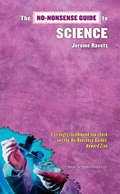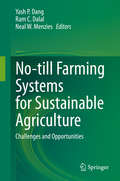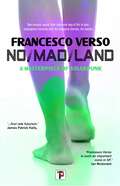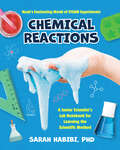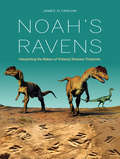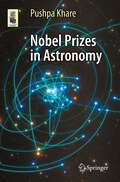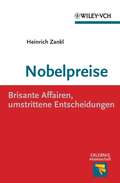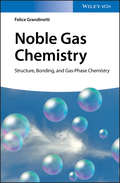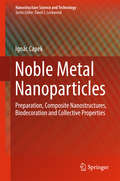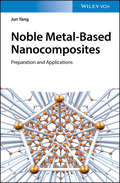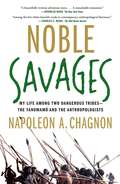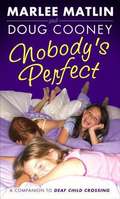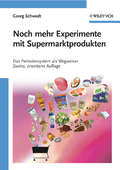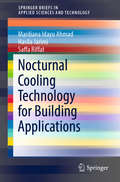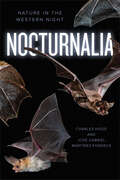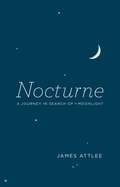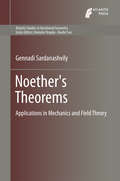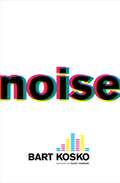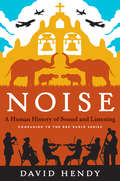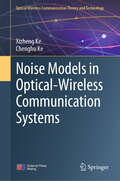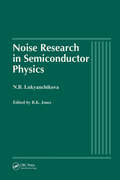- Table View
- List View
No-Nonsense Guide to Science (No-Nonsense Guides #21)
by Jerome RavetzScience is still the great intellectual adventure, but now it is also seen as an instrument of profit, power, and privilege. Wrongly used, it might yet make the 21st century our last.To make sense of all this, we need to let go of old ideas and assumptions. In the No-Nonsense Guide to Science, Jerome Ravetz introduces the “post-normal” way of thinking about science. We are to transcend the old simplistic ideas of perfect certainty and objectivity in science–they have failed to protect people and the environment when science has gone wrong and they have enabled flat, dogmatic teaching in our schools. We must now accept that value-loading, uncertainty, and ignorance are very real parts of science, and that citizens must participate in the policies that shape its evolution. The book also includes a refreshing new look at the history of science, and concludes with a series of questions that anyone can use to start their own exploration of the present and future of science.
No-till Farming Systems for Sustainable Agriculture: Challenges and Opportunities
by Yash P. Dang Ram C. Dalal Neal W. MenziesThis book is a comprehensive summary of current global research on no-till farming, and its benefits and challenges from various agronomic, environmental, social and economic perspectives. It details the characteristics and future requirements of no-till farming systems across different geographic and climatic regions, and outlines what is needed to increase the uptake of no-till farming globally. Over 35 chapters, this book covers in detail the agronomic and soil management issues that must be resolved to ensure the successful implementation of these systems. Important economic, environmental, social and policy considerations are discussed. It also features a series of case studies across a number of regions globally, highlighting the challenges and opportunities for no-till and how these may vary depending on climate and geopolitical location. This book is a remarkable compilation by experts in no-till farming systems. The promotion and expansion of no-till farming systems worldwide will be critical for food security, and resource and environmental sustainability. This is an invaluable reference for both researchers and practitioners grappling with the challenges of feeding the world’s rising population in an environment increasingly impacted by climate change. It is an essential reading for those seeking to understand the complexity of no-till farming systems and how best to optimise these systems in their region.
No/Mad/Land
by Francesco VersoA solarpunk masterpiece from a writer who champions a positive, inclusive and deep-thinking version of future possibilities.The Pulldogs leave Rome to embrace a new condition: leaving no trace of their passage, they shape a new challenging lifestyle: wandering around the world as neo-nomads to spread their solarpunk way of living and to engage on a never-ending mission to save endangered human cultures with nanites. But the vision of Alan and Nicolas about how the Pulldogs should live collide, and as a consequence, they split in two groups: one goes North to live in the beautiful wilderness of Siberia and Mongolia, while the other goes South to save the Dogon tribe from a possible extinction due to climate change in Central Africa. But at the end everybody - including a new generation of Pulldogs - will have to come back to Rome, where their incredible transformation started many years before. Sequel to the celebrated The Roamers.FLAME TREE PRESS is the imprint of long-standing Independent Flame Tree Publishing, dedicated to full-length original fiction in the horror and suspense, science fiction & fantasy, and crime / mystery / thriller categories. The list brings together fantastic new authors and the more established; the award winners, and exciting, original voices. Learn more about Flame Tree Press at www.flametreepress.com and connect on social media @FlameTreePress.
Noah's Fascinating World of STEAM Experiments: A Junior Scientist's Lab Notebook for Learning Scientific Method
by Sarah Habibi10 Fun STEAM Projects for Kids (Ages 8-12)#1 Bestseller in Children's Books on Chemistry and Children's Science Experiment Books“Sarah’s work as a STEAM educator is the perfect balance of creativity, fun, and science!”—Kellie Gerardi, bioastronautics researcher and space enthusiastFollow simple step-by-step instructions with Noah, your junior scientist guide, and explore STEAM experiments that are bubbly, colorful, big, and mind-blowing in this illustrated introduction to science, technology, engineering, art, and mathematics. Includes QR codes to Dr. Sarah Habibi's TikTok, so you can do the experiments alongside the author! A junior scientist’s guide to safe chemical reactions. Part illustrated fun, part STEAM workbook, Noah’s Fascinating World of STEAM Projects for Kids is the perfect addition to any kid scientist’s bookshelf. Dr. Sarah Habibi, the expert on TikTok science for kids and the brain behind the popular Science Bae videos, brings you 10 easy science experiments for kids to do right at home. Learn how to follow the scientific method by building a hypothesis, conducting a real experiment, and observing the results. Did something go wrong? That’s okay! Scientists mess up all the time—Noah and Dr. Habibi show you how to modify your experiment and try again.Inside, find 10 fun STEAM projects for kids, such as:Experiments with balloons and slime DIY Lava LampsWriting or drawing in invisible inkFamilies who enjoy fun science books and science activity books for kids—like Awesome Science Experiments for Kids, Steve Spangler's Super-Cool Science Experiments for Kids, The Future of Science is Female, or MinuteEarth Explains: How Did Whales Get So Big?—will love Noah’s Fascinating World of STEAM Projects for Kids.
Noah's Ravens: Interpreting the Makers of Tridactyl Dinosaur Footprints (Life of the Past)
by James O. FarlowHow can the tracks of dinosaurs best be interpreted and used to reconstruct them? In many Mesozoic sedimentary rock formations, fossilized footprints of bipedal, three-toed (tridactyl) dinosaurs are preserved in huge numbers, often with few or no skeletons. Such tracks sometimes provide the only clues to the former presence of dinosaurs, but their interpretation can be challenging: How different in size and shape can footprints be and yet have been made by the same kind of dinosaur? How similar can they be and yet have been made by different kinds of dinosaurs? To what extent can tridactyl dinosaur footprints serve as proxies for the biodiversity of their makers? Profusely illustrated and meticulously researched, Noah’s Ravens quantitatively explores a variety of approaches to interpreting the tracks, carefully examining within-species and across-species variability in foot and footprint shape in nonavian dinosaurs and their close living relatives. The results help decipher one of the world’s most important assemblages of fossil dinosaur tracks, found in sedimentary rocks deposited in ancient rift valleys of eastern North America. Those often beautifully preserved tracks were among the first studied by paleontologists, and they were initially interpreted as having been made by big birds—one of which was jokingly identified as Noah’s legendary raven.
Nobel Prizes in Astronomy (Astronomers' Universe)
by Pushpa KhareWritten in an accessible style, this unique book aims at describing the Nobel prize winning works in astronomy to readers who only have a background of high school physics. It gives a glimpse of the work done by those prize-winning astronomers at the forefront of research and the state-of-the-art techniques used for that, to an interested reader. There have been 11 years when Nobel prizes in physics have been given to astronomers. These award-winning works cover almost the entire subject of astronomy, starting from stellar structure all the way to cosmology. The prizes have been divided in 7 categories which are described in 7 chapters. For each prize a brief biography of the winner(s) is given first. The subject of the award is put into context and the reader is reminded of all the basic concepts needed for understanding the work before, finally, the prize-winning work is described. This enjoyable book will give the interested reader an excellent overview of the highlights and development of astronomy of the 20th and early 21st century.
Nobelpreise: Brisante Affairen, umstrittene Entscheidungen (Erlebnis Wissenschaft)
by Heinrich ZanklDer Nobelpreis ist die wichtigste Ehrung weltweit. Dass bei der Auswahl und Vergabe vielleicht nicht immer alles mit richtigen Dingen zugeht, ist nur menschlich - und dazu kann man viele interessante, witzige und prekäre Geschichten erzählen.
Noble Gas Chemistry: Structure, Bonding, and Gas-Phase Chemistry
by Felice GrandinettiAuthored by one of the world's leading experts in the chemistry of lighter noble gases, this comprehensive monograph fills the need for an up-to-date review of the diverse experimental techniques and theoretical methods currently in practice. After reviewing the experiments breaking the paradigm of "non-reactive" noble gases, the physico-chemical background is introduced. Besides the emphasis on gas phase reactions, the author presents other relevant systems, such as chemistry in the bulk phase, under high pressure, and cold matrices. The discussion of gas-phase chemistry of the noble gases covers neutral and ionic compounds, diatomic molecules, complexes with small molecules and metal compounds, up to large clusters.
Noble Metal Nanoparticles
by Ignác CapekThere is a growing interest in the use of nanoparticles modified with DNAs, viruses, peptides and proteins for the rational design of nanostructured functional materials and their use in biosensor applications. The challenge is to control the organization of biomolecules on nanoparticles while retaining their biological activity as potential chemical and gene therapeutics. These noble metal nanoparticles/biomolecules conjugates have specific properties and therefore they are attractive materials for nanotechnology in biochemistry and medicine. In this book, the author review work performed dealing with the DNA structure and functionalities, interactions between DNA, noble metal nanoparticles, surface active agents, solvents and other additives. Particular attention is given to how the DNA's chain length and the DNA conformation affect the interaction and structure of the nanoconjugates and nanostructures that are formed. Also discussed are the recent advances in the preparation, characterization, and applications of noble metal nanoparticles that are conjugated with DNA aptamers and oligomers. The advantages and disadvantages of functionalized nanoparticles through various detection modes are highlighted, including colorimetry, fluorescence, electrochemistry, SPR, and, mass spectrometry for the detection of small molecules and biomolecules. The functionalized noble metal nanoparticles are selective and sensitive for the analytes, showing their great potential in biosensing. Furthermore, this book reviews recent progress in the area of DNA-noble metal nanoparticles based artificial nanostructures, that is, the preparation, collective properties, and applications of various DNA-based nanostructures are also described.
Noble Metal-Based Nanocomposites: Preparation and Applications
by Jun YangProvides a systematic and coherent picture of the solution-based methods for the preparation of noble metal-based composite nanomaterials, their characterization, and potential applications in electrocatalysis Within the last decade, the development of wet-chemistry methods has led to the blossom of research in composite nanomaterials. However, the design and synthesis of composite nanomaterials with controlled properties remains a significant challenge. This book summarizes the solution-based methods for the preparation of noble metal-based composite nanomaterials. It examines their characterization, as well as their use in electrocatalysis. It also discusses the intrinsic relationship between the catalytic properties and the physical /chemical effects in the composite materials, and offers some perspectives for the future development of metal-based composite nanomaterials. In addition, the book not only provides a systematic and coherent picture of this field, but also inspires rethinking of the current processing technologies. Noble Metal-Based Nanocomposites: Preparation and Applications offers in-depth chapter coverage of ethanol-mediated phase transfer of metal ions and nanoparticles. It presents the full range of nanocomposites consisting of chalcogenide semiconductors and gold, silver sulfide, or other noble metals. It also examines core-shell structured cadmium selenide-platinum nanocomposites; Pt-containing Ag2S-noble metal nanocomposites for direct methanol fuel cells operated at high fuel concentrations; and nanocomposites consisting of metal oxides and noble metals. In addition, the book looks at scientific issues derived from noble metal-based nanocomposites. -Covers all of the preparations of noble metal-based nanocomposites and their numerous applications -Highlights some of the recent breakthroughs in the design, engineering, and applications of noble metal-based nanocomposites -Appeals to a wide range audience, especially researchers in the areas of catalysis, chemistry, chemical engineering, materials synthesis and characterization, and fuel cell Noble Metal-Based Nanocomposites: Preparation and Applications is an excellent book for inorganic chemists, materials scientists, catalytic chemists, chemical engineers, and those interested in the subject.
Noble Savages: My Life Among Two Dangerous Tribes -- The Yanomamo and the Anthropologists
by Napoleon ChagnonONE OF THE MOST IMPORTANT SCIENTIFIC MEMOIRS OF OUR TIME When Napoleon Chagnon arrived in Venezuela's Amazon region in 1964 to study the Yanomamö Indians, one of the last large tribal groups still living in isolation, he expected to find Rousseau's "noble savages," so-called primitive people living contentedly in a pristine state of nature. Instead Chagnon discovered a remarkably violent society. Men who killed others had the most wives and offspring, their violence possibly giving them an evolutionary advantage. The prime reasons for violence, Chagnon found, were to avenge deaths and, if possible, abduct women. When Chagnon began publishing his observations, some cultural anthropologists who could not accept an evolutionary basis for human behavior refused to believe them. Chagnon became perhaps the most famous American anthropologist since Margaret Mead--and the most controversial. He was attacked in a scathing popular book, whose central allegation that he helped start a measles epidemic among the Yanomamö was quickly disproven, and the American Anthropological Association condemned him, only to rescind its condemnation after a vote by the membership. Throughout his career Chagnon insisted on an evidence-based scientific approach to anthropology, even as his professional association dithered over whether it really is a scientific organization. In Noble Savages, Chagnon describes his seminal fieldwork--during which he lived among the Yanomamö, was threatened by tyrannical headmen, and experienced an uncomfortably close encounter with a jaguar--taking readers inside Yanomamö villages to glimpse the kind of life our distant ancestors may have lived thousands of years ago. And he forcefully indicts his discipline of cultural anthropology, accusing it of having traded its scientific mission for political activism. This book, like Chagnon's research, raises fundamental questions about human nature itself.
Nobody's Perfect
by Marlee Matlin Doug Cooney"She's practically perfect," Megan said thoughtfully. She repeated the new girl's name, practicing the way Ms. Endee had written it on the whiteboard. Alexis Powell. Megan has spent forever planning her positively purple birthday sleepover. She's even made glittery purple invitations for every girl in her class. Then a new girl, Alexis, joins their class. Alexis seems perfect: She's smart, pretty, and rules the soccer games on the playground. But no matter how hard Megan tries to be a friend to Alexis, the new girl is aloof or rude. At first, Megan thinks Alexis is shy. Then Megan starts to fear that Alexis is treating her differently because she's deaf. When the girls are forced to collaborate on a science fair project, Megan learns the truth -- and realizes that nobody's perfect. Once again Marlee Matlin draws on experiences from her own childhood to tell Megan's story. In this funny, poignant book, readers will root for Megan, a spirited young girl who doesn't let anything stand in her way.
Noch mehr Experimente mit Supermarktprodukten: Das Periodensystem als Wegweiser
by Georg SchwedtHollenstein und Borax! Das klingt ja wie ein Hexenspruch - hat Chemie etwa mit Zauberei zu tun? Wer wei? schon, welche Geheimnisse hinter Rote-Beete-Saft und pH-Indikator steckt? Georg Schwedt erklart es muhelos Lehrern, Schulern, Studienanfangern und allen anderen, die es wissen wollen. Erstaunlich, wie viel einpragsamer das Lernen und Begreifen ist, wenn man mit Alltagsgegenstanden und Haushaltsmitteln spannende aber gefahrlose Experimente durchfuhren kann! Im Unterschied zu Georg Schwedts erfolgreichem, nunmehr in dritter Auflage vorliegenden Buch "Experimente mit Supermarktprodukten" sind die Versuche hier nicht anhand einer chemischen Warenkunde strukturiert, sondern orientieren sich an der Ordnung des Periodensystems der chemischen Elemente - vom Wasserstoff hin zu den Halogenen. Mit handelsublichen Supermarktprodukten und ein paar gewohnlichen Reagenzien sind alle Versuche durchzufuhren. Die Rezepturen sind an das aktuelle Angebot der Supermarkte angepasst. Also, kann's doch gleich losgehen, oder?
Nocturnal Cooling Technology for Building Applications (SpringerBriefs in Applied Sciences and Technology)
by Mardiana Idayu Ahmad Saffa Riffat Hasila JarimiThis book discusses nocturnal cooling technologies for building applications. Exploiting the natural environment as a renewable and sustainable resource has become a significant strategy for passive energy saving in buildings, and has led to growing interest in the use of passive radiative cooling based on nighttime (nocturnal) and daytime (diurnal) operating periods. Of these, nocturnal cooling is more promising since diurnal cooling is hard to achieve due to the solar radiation effect. As such, this book provides a comprehensive overview of nocturnal cooling for building applications, including a definition, concepts and principles; materials and devices; and cooling systems and configurations.
Nocturnalia: Nature in the Western Night
by Charles Hood José Gabriel Martínez-FonsecaDon’t be afraid of the dark: grab a flashlight and rediscover your sense of adventure!Darkness is something humans strive to keep at bay, but under the glow of twilight a nocturnal universe stirs to life. Nightshade blossoms bloom, javelinas parade down city streets, fox eyes gleam under the cover of the forest, and tiny sparrows fly incredible distances, guided by the stars. Naturalist Charles Hood and bat biologist José Gabriel Martínez-Fonseca unravel these enigmas in Nocturnalia, inviting readers on an environmental romp through the wonders of the Wild West. Their sundown dispatches, featuring over 100 photographs from California and the American Southwest, take us from the astronomical canopy overhead, to the flora that unfurl under moonshine, to the creatures that go bump in the night. With practical tips for the budding nighttime naturalist, the authors invite citizen scientists of all stripes to expand our knowledge of this final frontier and our understanding of life on Earth. Exploring the evolutionary adaptations of owls, bats, and other nightlife animals; the natural history of nighttime plants; and the celestial patterns that regulate this after-dark kingdom, Hood and Martínez-Fonseca lift their lanterns to illuminate the exquisite and intricate inner workings of nature after nightfall.
Nocturne: A Journey in Search of Moonlight
by James Attlee"Nobody who has not taken one can imagine the beauty of a walk through Rome by full moon," wrote Goethe in 1787. Sadly, the imagination is all we have today: in Rome, as in every other modern city, moonlight has been banished, replaced by the twenty-four-hour glow of streetlights in a world that never sleeps. Moonlight, for most of us, is no more. So James Attlee set out to find it. Nocturne is the record of that journey, a traveler's tale that takes readers on a dazzling nighttime trek that ranges across continents, from prehistory to the present, and through both the physical world and the realms of art and literature. Attlee attends a Buddhist full-moon ceremony in Japan, meets a moon jellyfish on a beach in Northern France, takes a moonlit hike in the Arizona desert, and experiences a lunar eclipse on New Year's Eve atop the snowbound Welsh hills. Each locale is illuminated not just by the moonlight he seeks, but by the culture and history that define it. We learn about Mussolini's pathological fear of moonlight; trace the connections between Caspar David Friedrich, Rudolf Hess, and the Apollo space mission; and meet the inventors of the Moonlight Collector in the American desert, who aim to cure all kinds of ailments with concentrated lunar rays. Svevo and Blake, Whistler and Hokusai, Li Po and Marinetti are all enlisted, as foils, friends, or fellow travelers, on Attlee's journey. Pulled by the moon like the tide, Attlee is firmly in a tradition of wandering pilgrims that stretches from Basho to Sebald; like them, he presents our familiar world anew.
Noether's Theorems
by Gennadi SardanashvilyThe book provides a detailed exposition of the calculus of variations on fibre bundles and graded manifolds. It presents applications in such area's as non-relativistic mechanics, gauge theory, gravitation theory and topological field theory with emphasis on energy and energy-momentum conservation laws. Within this general context the first and second Noether theorems are treated in the very general setting of reducible degenerate graded Lagrangian theory.
Noise
by Bart KoskoFrom the well-known science commentator and bestselling author of Fuzzy Thinking comes a revelatory look at the phenomenon of noise<P> A celebrated maverick in the world of science, Bart Kosko introduced—and continues to popularize in print and television media—the revolutionary concept of fuzzy logic. In his latest book, he provides the first scientific history of noise aimed at the general reader.<P> Noise is a social nuisance, a cause of deafness and high blood pressure, and an all-around annoyance. But what is noise really? As Kosko simply states, "Noise is a signal that you don’t like." It occurs at every level of the physical universe, from the big bang to blaring car alarms. Today, noise is considered the curse of the information age, but, in fact, not all noise is bad. Debunking this and many other commonly held beliefs about noise, Kosko gives readers a vivid sense of how deeply noise permeates both the world around us and within us. Along the way he covers many compelling topics, from noise’s possible role in the ice ages to noise pollution laws, the use of noise to generate synthetic speech, and Hedy Lamarr’s contribution to noisy wireless communication. The result is a vastly entertaining and illuminating scientific journey that promises to do for noise what James Gleick did for chaos—make it vital, fascinating, and relevant.
Noise
by David HendyWhat if history had a sound track? What would it tell us about ourselves? Based on a thirty-part BBC Radio series and podcast, Noise explores the human dramas that have revolved around sound at various points in the last 100,000 years, allowing us to think in fresh ways about the meaning of our collective past. Though we might see ourselves inhabiting a visual world, our lives have always been hugely influenced by our need to hear and be heard. To tell the story of sound—music and speech, but also echoes, chanting, drumbeats, bells, thunder, gunfire, the noise of crowds, the rumbles of the human body, laughter, silence, conversations, mechanical sounds, noisy neighbors, musical recordings, and radio—is to explain how we learned to overcome our fears about the natural world, perhaps even to control it; how we learned to communicate with, understand, and live alongside our fellow beings; how we've fought with one another for dominance; how we've sought to find privacy in an increasingly noisy world; and how we've struggled with our emotions and our sanity. Oratory in ancient Rome was important not just for the words spoken but for the sounds made—the tone, the cadence, the pitch of the voice—how that voice might have been transformed by the environment in which it was heard and how the audience might have responded to it. For the Native American tribes first encountering the European colonists, to lose one's voice was to lose oneself. In order to dominate the Native Americans, European colonists went to great effort to silence them, to replace their "demonic" "roars" with the more familiar "bugles, speaking trumpets, and gongs. " Breaking up the history of sound into prehistoric noise, the age of oratory, the sounds of religion, the sounds of power and revolt, the rise of machines, and what he calls our "amplified age," Hendy teases out continuities and breaches in our long relationship with sound in order to bring new meaning to the human story.
Noise Matters
by R. Haven WileyWe think of noise as background sound that interferes with our ability to hear more interesting sounds. But noise is anything that interferes with the reception of signals of any sort. Whatever its cause, the consequence of noise is error by receivers, and these errors are the key to understanding how noise shapes the evolution of communication.
Noise Models in Optical-Wireless Communication Systems (Optical Wireless Communication Theory and Technology)
by Xizheng Ke Chenghu KeThe book focuses on noise models in optical-wireless communication systems. The main contents include noise classification in optical-wireless communication systems, as well as the current research progress at home and abroad, explores the noise mechanism in optical-wireless communication systems, as well as the establishment of a noise model and analysis methods to suppress the noise of optical-wireless communication systems. Combining theory with practice, systematic analysis of all kinds of noise in optical-wireless communication system, so that readers have a comprehensive understanding of the noise in optical-wireless communication system, which is an important feature of this book. The book can benefit senior college students in electronic information, communication engineering, and applied optical majors, as well as graduates, engineers, and technical personnel, etc.
Noise Research in Semiconductor Physics
by N. B. LukyanchikovaThis book demonstrates the role and abilities of fluctuation in semiconductor physics, and shows what kinds of physical information are involved in the noise characteristics of semiconductor materials and devices, how this information may be decoded and which advantages are inherent to the noise methods. The text provides a comprehensive account of current results, addressing problems which have not previously been covered in Western literature, including the excess noise of tunnel-recombination currents and photocurrents in diodes, fluctuation phenomena in a real photoconductor with different recombination centers, and methods of noise spectroscopy of levels in a wide range of materials and devices.
Noise and Fluctuations: An Introduction
by D. K. MacDonaldAn understanding of fluctuations and their role is both useful and fundamental to the study of physics. This concise study of random processes offers graduate students and research physicists a survey that encompasses both the relationship of Brownian Movement with statistical mechanics and the problem of irreversible processes. It outlines the basics of the physics involved, without the strictures of mathematical rigor.The three-part treatment starts with a general survey of Brownian Movement, including electrical Brownian Movement and "shot-noise," Part two explores correlation, frequency spectrum, and distribution function, with particular focus on application to Brownian Movement. The final section examines noise in electric currents, including noise in vacuum tubes and a random rectangular current. Frequent footnotes amplify the text, along with an extensive selection of Appendixes.
Noise and Randomness in Living System
by Sisir Roy Sarangam MajumdarThis book illustrates the role of randomness and noise in living organisms. Traditionally, the randomness and noise have been used in understanding signal processing in communications. This book is divided into two sections, the first of which introduces readers to the various types and sources of noise and the constructive role of noise in non-linear dynamics. It also analyses the importance of randomness and noise in a variety of science and engineering applications. In turn, the second section discusses in detail the functional role of noise in biological processes for example, in case of brain function at the level of ion channel, synaptic level and even at cognitive level. These are described in various chapters. One of the challenging issue finding the neuronal correlates of various meditative states is to understand how brain controls various types of noise so as to reach a state of synchronized oscillatory state of the brain corresponding to the state of Samadhi. This is described in details in one chapter called Noise, Coherence and meditation. The concept of noise and the role of randomness in living organism raise lot of controversy for last few decades. This is discussed in a separate chapter. Finally, the epistemic and ontic nature of randomness as discussed in physical science are investigated in the context of living organism.
Noise and Vibration Control on Ships: Understanding and Cutting Through the Noise
by Raymond Fischer Leonid BoroditskyThis book provides a guide for the marine community to understand and address the noise and vibration environment associated with ships. Controlling noise and vibration in an effective and optimal manner requires a comprehensive understanding of all the ship systems that are involved in achieving a quiet vessel. While there are numerous published articles addressing various components of shipboard noise and vibration, this represents the first comprehensive book on the subject. Beginning from the basic acoustics of noise and vibration, it builds to more complex considerations in undersea sound, ship design, and compliance. The book provides an understanding of the ‘source-path-receiver’ modelling of shipboard noise and vibration. It delivers an overview of how to select and optimize both noise and vibration control treatments along with design guidance and methods to demonstrate compliance with acoustic regulations. It reflects the knowledge gained by the authors consulting over 40years each on hundreds of vessels, and represents an invaluable resource for ship builders and marine engineers.
